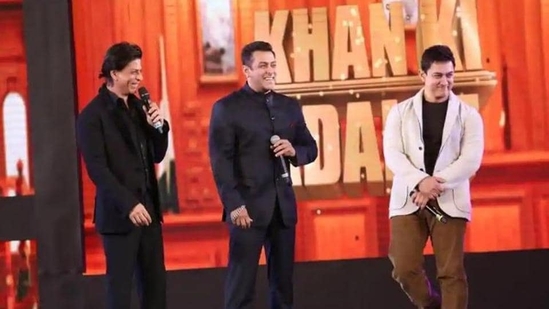Just Like That | Bollywood's reigning stars teach us an important lesson about India's syncretic culture
The superstar status of all three Khans — Aamir, Shahrukh and Salman — remains unchanged to this day. In their popularity we see the true nature of us Indians
Do you know what is common between Shahrukh Khan, Salman Khan and Aamir Khan? It is not just the thought that they have been the ruling trinity in Bollywood for decades now. Or that they have a string of blockbusters behind them, and became legends in their lifetime. The interesting common factor is that all three of them were born in 1965.

That is, indeed, a remarkable coincidence. To have three superstars with the same surname, each 58 years old, is something that may not be so widely known. The fact that all three of them still play romantic characters as young men, and are accepted by audiences in these roles when they are about to turn 60, is a tribute to their enduring cinematic appeal.
It is often debated which of them is the most successful. Shahrukh, popularly known as SRK, is called ‘King Khan’, or the ‘Badshah of Bollywood’. Salman is dubbed ‘The Tiger of Bollywood’. And Aamir has been given the title of ‘Mr Perfectionist’. All three actors reached their peak in the 1990s. SRK’s career took off in 1993 when his three superhits were released, Baazigar, Darr, and Kabhi Haan Kabhi Naa. These were followed in the next few years by box-office blockbusters, Dilwale Dulhaniya Le Jayenge (1995), Dil Toh Paagal Hai (1997), Kuch Kuch Hota Hai (1998), and in 2001, the iconic Kabhi Khushi Kabhi Gham.
Over the next decade, his career continued to touch new heights, with a series of successful films, of which, for me, the most entertaining were Chak de India, and Chennai Express. Last year, his films Pathaan and Jawaan, ranked among the highest-grossing films of all time. A third film, Dunki, although a little less successful, has still raked in ₹400 crores worldwide, more than three times its budget.
Salman Khan’s career zoomed with an unexpected hit in 1989, the romantic film, Maine Pyaar Kiya. In 1994, Salman starred in the first Bollywood film that broke the ₹100 crore barrier, Hum Aapke Hai Kaun. His cinematic graph touched a new high in the decade starting in 2010, with films like Dabangg (2010) and its sequels, Bodyguard (2011), Ek Tha Tiger (2012), which became the highest-grossing film of that year, Kick (2014), Bajrangi Bhaijaan (2015) and Tiger Zinda Hai (2017).
Aamir Khan is less prolific and more selective about the films he does. His successful commercial career launched about the same time as Salman’s, with again an improbable hit in the form of the tragic romance, Qayamat Se Qayamat Tak (1988). Raja Hindustani (1996) and Ghajini (2008) were other runaway successes. Lagaan in 2001 was not only a smash hit, but also India’s offering for the Oscar awards, and won Aamir the Filmfare Award for best actor. Rang De Basanti (2006) and 3 Idiots (2009)—one of the most watched films especially by the young—were also blockbusters. But his most successful film ever was Dangal (2016), which inaugurated the ₹1,000-Crore Club and ultimately grossed over ₹2,000 crore, making it the highest-grossing film ever, not only in India but also China, the third largest film market in the world.
All three Khans have other things in common too. All of them are among the highest-earning actors in the world. Two of them—SRK and Aamir—have opened their own film production houses. All three of them have been victims of ‘cancel culture’, but have managed to emerge out of controversy or politics. Apart from their highs, each of them saw lows, staying away from the limelight for several years before coming back with a bang just when people were writing them off. SRK’s success is all the greater because he did not come from a filmi background but made it on his own as an outsider. Aamir and Salman’s family were a part of the film world.
There was, before the current Khan trinity—another Khan who was perhaps in his prime even more successful, and is considered a foundational legend of Bollywood. His name was Muhammad Yusuf Khan, known to the world by his screen avatar, Dilip Kumar. In the 1950s and 60s, he was the highest-paid colossus of Hindi cinema, overshadowing his other two very popular contemporaries, Dev Anand and Raj Kapoor. In 1960, his film Mughal-e-Azam, where he played Emperor Akbar with the ethereal Madhubala as Anarkali, became a super hit and is considered the highest-grossing Bollywood film of all time if adjusted for inflation, which remained a record for six decades thereafter.
There are other Khans too, who in their own way, have created a niche for themselves in the highly competitive world of Hindi films—Saif Ali Khan, the late Irrfan Khan, and the late character artiste, Kader Khan.
In a country, where the majority are Hindus, it is a tribute to our syncretic culture that the Khans have never been seen through the prism of religion but are hugely popular for their talents and their resilient ability to provide enduring entertainment.
Here’s wishing the three Khans all the very best in the future.
Pavan K Varma is author, diplomat, and former Member of Parliament (Rajya Sabha).
Just Like That is a weekly column where Varma shares nuggets from the world of history, culture, literature, and personal reminiscences with HT Premium readers
The views expressed are personal
All Access.
One Subscription.
Get 360° coverage—from daily headlines
to 100 year archives.



HT App & Website







